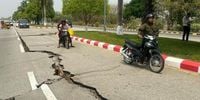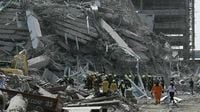A powerful earthquake of magnitude 7.7 struck central Myanmar on March 28, 2025, sending shockwaves felt as far as Thailand and China. The earthquake, which occurred at approximately 14:20 local time, was centered 16 kilometers northwest of the city of Sagaing, according to the United States Geological Survey (USGS).
In Myanmar's capital, Naypyidaw, the tremors caused significant damage, with roads deformed and pieces of ceiling falling from buildings. Eyewitnesses reported chaotic scenes as people rushed to evacuate. "It's a mass casualty area," stated a hospital official as the facility received hundreds of injured individuals. Reports indicate that around 20 people have died due to the earthquake at this hospital alone.
The impact of the quake extended beyond Myanmar's borders. In Bangkok, Thailand, panic ensued as the tremors prompted evacuations of offices and shops. A 30-story building under construction collapsed, resulting in at least three confirmed deaths and 81 individuals still missing in the rubble. Prime Minister Paetongtarn Shinawatra declared a state of emergency in Bangkok following the disaster.
As the situation unfolded, the European Union announced its readiness to provide emergency aid to both Myanmar and Thailand. Ursula von der Leyen, President of the European Commission, expressed her condolences on social media, stating, "Heartbreaking scenes in Myanmar and Thailand after the devastating earthquake. My thoughts are with the victims and their families." Meanwhile, Indian Prime Minister Narendra Modi also offered assistance, emphasizing India's readiness to help.
In Myanmar, the military junta has officially called for international aid, a rare move for a regime that has largely isolated itself since the coup in 2021. The junta declared a state of emergency in six regions, reflecting the extensive damage reported across the country. The Mandalay Palace, a significant historical site built in 1857, was partially destroyed, and several bridges were reported collapsed, complicating rescue efforts.
Reports from the Red Cross indicate that the situation is dire, with fears that dams on the Irrawaddy River may have been compromised, posing additional risks to the affected populations. Approximately 18.5 million people live in the areas surrounding the earthquake's epicenter, many of whom are already vulnerable due to ongoing conflicts and lack of infrastructure.
As the day progressed, scientists warned of potential aftershocks, estimating that tremors of magnitude 6 to 6.5 could occur in the following hours and days. Geophysicist Oliver Heidbach from the German Research Centre for Geosciences noted, "We expect aftershocks. This is a typical process, but it could complicate rescue operations due to already damaged buildings."
In Naypyidaw, the main hospital reported a "mass casualty area" with hundreds of victims arriving for treatment. Some patients were seen lying on the ground outside the emergency department due to overcrowding. A doctor at the hospital lamented, "I have never seen anything like this. We are trying to manage the situation, but it is overwhelming." Eyewitness accounts describe scenes of chaos, with family members desperately trying to locate their loved ones amid the turmoil.
In Bangkok, the tremors led to surprising scenes as swimming pools atop high-rise buildings overflowed, cascading water down to the streets below. Local residents shared their experiences, with one individual recounting, "I was in my room on the 16th floor when the building suddenly shook for about thirty seconds. We all rushed outside. It was terrifying!" Another resident described the panic as they fled their apartment, noting that it was the strongest tremor they had ever felt.
As of the latest reports, the death toll has risen, with at least 16 confirmed fatalities across both Myanmar and Thailand. However, officials caution that these numbers are likely to rise as rescue efforts continue and the extent of the damage is assessed.
The earthquake's aftermath poses significant challenges for both countries, particularly Myanmar, which has been grappling with civil unrest and a lack of robust emergency response infrastructure. The international community's response will be critical in addressing the immediate needs of those affected and aiding in recovery efforts.
In summary, the earthquake that struck Myanmar on March 28 has resulted in widespread devastation, prompting urgent calls for international assistance and highlighting the vulnerabilities of a region already facing numerous challenges. As rescue operations unfold, the focus will remain on providing aid to the countless victims affected by this disaster.










